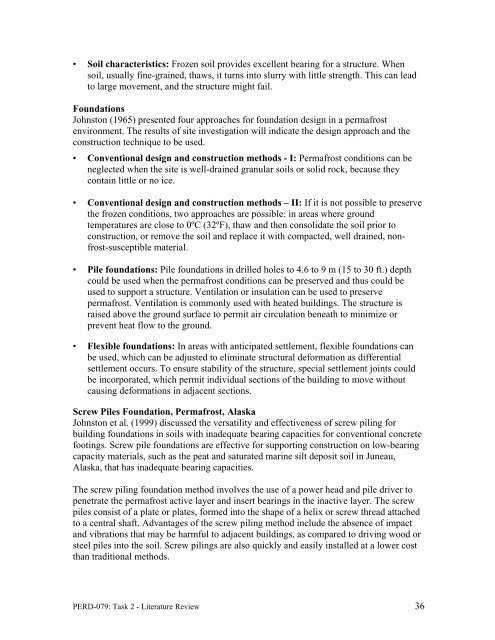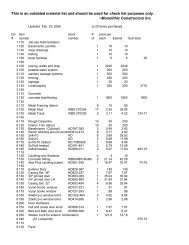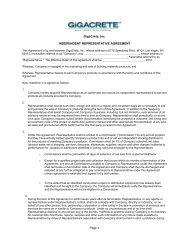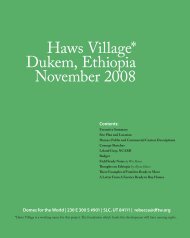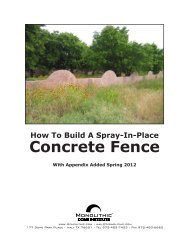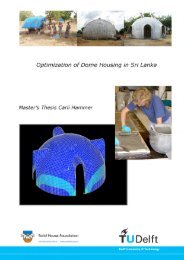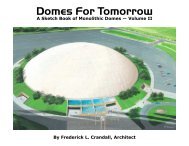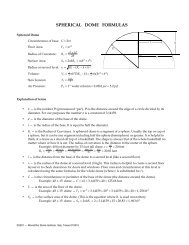Literature Review on Building Envelope, Heating and ... - Beeshive.org
Literature Review on Building Envelope, Heating and ... - Beeshive.org
Literature Review on Building Envelope, Heating and ... - Beeshive.org
You also want an ePaper? Increase the reach of your titles
YUMPU automatically turns print PDFs into web optimized ePapers that Google loves.
• Soil characteristics: Frozen soil provides excellent bearing for a structure. When<br />
soil, usually fine-grained, thaws, it turns into slurry with little strength. This can lead<br />
to large movement, <strong>and</strong> the structure might fail.<br />
Foundati<strong>on</strong>s<br />
Johnst<strong>on</strong> (1965) presented four approaches for foundati<strong>on</strong> design in a permafrost<br />
envir<strong>on</strong>ment. The results of site investigati<strong>on</strong> will indicate the design approach <strong>and</strong> the<br />
c<strong>on</strong>structi<strong>on</strong> technique to be used.<br />
• C<strong>on</strong>venti<strong>on</strong>al design <strong>and</strong> c<strong>on</strong>structi<strong>on</strong> methods - I: Permafrost c<strong>on</strong>diti<strong>on</strong>s can be<br />
neglected when the site is well-drained granular soils or solid rock, because they<br />
c<strong>on</strong>tain little or no ice.<br />
• C<strong>on</strong>venti<strong>on</strong>al design <strong>and</strong> c<strong>on</strong>structi<strong>on</strong> methods – II: If it is not possible to preserve<br />
the frozen c<strong>on</strong>diti<strong>on</strong>s, two approaches are possible: in areas where ground<br />
temperatures are close to 0ºC (32ºF), thaw <strong>and</strong> then c<strong>on</strong>solidate the soil prior to<br />
c<strong>on</strong>structi<strong>on</strong>, or remove the soil <strong>and</strong> replace it with compacted, well drained, n<strong>on</strong>frost-susceptible<br />
material.<br />
• Pile foundati<strong>on</strong>s: Pile foundati<strong>on</strong>s in drilled holes to 4.6 to 9 m (15 to 30 ft.) depth<br />
could be used when the permafrost c<strong>on</strong>diti<strong>on</strong>s can be preserved <strong>and</strong> thus could be<br />
used to support a structure. Ventilati<strong>on</strong> or insulati<strong>on</strong> can be used to preserve<br />
permafrost. Ventilati<strong>on</strong> is comm<strong>on</strong>ly used with heated buildings. The structure is<br />
raised above the ground surface to permit air circulati<strong>on</strong> beneath to minimize or<br />
prevent heat flow to the ground.<br />
• Flexible foundati<strong>on</strong>s: In areas with anticipated settlement, flexible foundati<strong>on</strong>s can<br />
be used, which can be adjusted to eliminate structural deformati<strong>on</strong> as differential<br />
settlement occurs. To ensure stability of the structure, special settlement joints could<br />
be incorporated, which permit individual secti<strong>on</strong>s of the building to move without<br />
causing deformati<strong>on</strong>s in adjacent secti<strong>on</strong>s.<br />
Screw Piles Foundati<strong>on</strong>, Permafrost, Alaska<br />
Johnst<strong>on</strong> et al. (1999) discussed the versatility <strong>and</strong> effectiveness of screw piling for<br />
building foundati<strong>on</strong>s in soils with inadequate bearing capacities for c<strong>on</strong>venti<strong>on</strong>al c<strong>on</strong>crete<br />
footings. Screw pile foundati<strong>on</strong>s are effective for supporting c<strong>on</strong>structi<strong>on</strong> <strong>on</strong> low-bearing<br />
capacity materials, such as the peat <strong>and</strong> saturated marine silt deposit soil in Juneau,<br />
Alaska, that has inadequate bearing capacities.<br />
The screw piling foundati<strong>on</strong> method involves the use of a power head <strong>and</strong> pile driver to<br />
penetrate the permafrost active layer <strong>and</strong> insert bearings in the inactive layer. The screw<br />
piles c<strong>on</strong>sist of a plate or plates, formed into the shape of a helix or screw thread attached<br />
to a central shaft. Advantages of the screw piling method include the absence of impact<br />
<strong>and</strong> vibrati<strong>on</strong>s that may be harmful to adjacent buildings, as compared to driving wood or<br />
steel piles into the soil. Screw pilings are also quickly <strong>and</strong> easily installed at a lower cost<br />
than traditi<strong>on</strong>al methods.<br />
PERD-079: Task 2 - <str<strong>on</strong>g>Literature</str<strong>on</strong>g> <str<strong>on</strong>g>Review</str<strong>on</strong>g> 36


